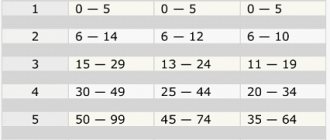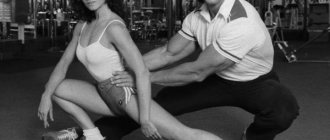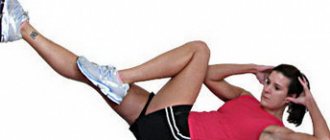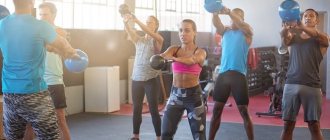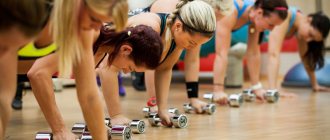How do muscles grow, what triggers their growth and how can we use this in training?
The body does not like change and strives to remain in the comfort zone - that is, to maintain homeostasis and maintain a constant internal environment. But if there is a need, he knows how to adapt to new conditions and develop new qualities in order to endure unusual stress more easily.
Lifting weights is a stress and threat to the body, which it tries to adapt to by increasing muscle size and making a person stronger.
This principle of overload is the most important thing for muscle growth, which is why we have to go to the gym several times a week, for years, and constantly increase the load to maintain controlled stress. If we stop loading the muscles, the body will get rid of all the extra, unnecessary fibers that no longer work - it is not economically profitable for it to support and maintain what is not used.
Many beginners believe that muscles grow during training, although, in fact, during training the opposite happens: there they are destroyed. It's like renovating a house: you have to take down the old to install the new. And muscles grow on rest days. During training, we stress the muscles (create a stimulus), and repair and strengthening occurs within 36-72 hours after. During this time, the muscles are not only restored to their previous level, but also grow a little more, “with a margin”, so that next time it will be easier - this is called supercompensation .
Today, science knows three main mechanisms of muscle growth that are triggered by training. All of them are controlled stress:
- Mechanical tension in the muscle in response to heavy load.
- Metabolic stress (cell acidification with glycogen breakdown products).
- Damage to muscle fibers.
Muscle tension
When we lift heavy weights, it's hard for us. Sometimes you can feel that the muscles are ready to tear away from the bone - this is a lot of mechanical tension in the muscle, and it is considered the most important in muscle growth.
A large load means the risk of damage and death of both a specific muscle cell and the entire organism. In response, the brain decides to strengthen the body and, with the help of anabolic hormones, signals muscle growth and improves neuromuscular connections (strength).
But it seems that there is a threshold in the magnitude of the load beyond which muscle growth ceases, and then other factors become increasingly important. This is why bodybuilders have larger muscles than powerlifters, even though they train with lighter weights, while powerlifters are much stronger.
It is also known that working with light weights, but repeatedly and to failure, is also effective for muscle growth: as the fibers responsible for endurance get tired, white (fast) fibers are connected, which usually immediately connect when working with heavy weights and well grow.
Training program
I started with the basic program, as is recommended for all beginners.
Basic exercises, minimum number of approaches, no more than 6-7 repetitions per exercise. A little later, I began to separate the workouts for the upper and lower body, and repeat each twice a week. In addition, once a week I do a cardio day and run 8 kilometers. I believe that this allows the muscles to recover after exercise, as the blood circulates faster and toxins are aggressively flushed out. But I do cardio on a separate day.
Fiber damage
12-24 hours after an intense workout, the muscles often begin to ache slightly (or not slightly, if there was too much stress). The reason is damage to the contractile proteins inside the muscle cell, and sometimes in the cell membrane. Some mild (!) soreness can indirectly affect muscle growth.
The body's response to muscle damage can be compared to an acute inflammatory response to an infection. Immune cells (neutrophils, macrophages and others) are sent to the damaged tissue to remove cell debris and help maintain fiber structure. The body also produces signaling molecules - cytokines. All of this leads to a response that triggers muscle growth so that it can be more resistant to future damage.
However, muscle pain is by no means a necessary condition for growth. Over time, muscles, connective tissue, and the immune system become increasingly effective at fighting fiber damage. The longer and more intensely you train, the less pain you may feel (unless, of course, the load suddenly turns out to be too heavy).
If after training it hurts to walk, sit, raise and lower your arms, you have exceeded your body's ability to recover. The goal is to stimulate, not destroy.
There are people who never experience any discomfort after training, but they also grow because microdamages can occur without pain.
Diet for muscles
The main rules of the diet for muscle gain are very simple: + 20% to the daily calorie intake, 200-250 grams of pure protein (remember that 100 g of chicken has only 20 g of protein), approximately 80 grams of fat, and the remaining calories from various carbohydrates.
When working on muscles, don't be afraid to gain a little fat - the body either gains mass or doesn't, and when it gains it, not only muscle comes, but also fat. If you're afraid of fat, you won't gain muscle. The main thing is to know the moment when to stop.
Metabolic stress
Even if not everyone knows what it is, everyone is familiar with a strong burning sensation in the muscle during exercises of ~12 repetitions per set and above.
What is metabolic stress? Long muscle contraction compresses the blood vessels and “locks” the blood in the cells. New blood with oxygen does not temporarily enter the cell and metabolic products (lactate, hydrogen ions, inorganic phosphate) do not leave it. A kind of chemical poisoning of the cell occurs, there is a risk of its death, and in response to this the body again decides to strengthen itself.
There is a version that muscle growth can also be affected by “pumping” - swelling of the muscle after training, giving it volume for several hours. Scientists suggest that excess water in the cell stretches it. The cell again perceives this as a threat to its integrity and sends anabolic signals that trigger growth.
Features of sports metabolism
Types of metabolism
The nuances of athletes' metabolism are characterized by the loads they receive during training.
- The first type develops under large intense loads. It occurs with increased consumption of plastic components. Additionally, such metabolism can be characterized by an increased level of use of intramuscular resources. In this case, proteolytic processes in protein metabolism significantly prevail over synthetic ones. This means that with excessive training, muscles will not grow intensively.
- The second type is characteristic of those who practice medium and moderate loads. In such cases, the use of extramuscular energy sources predominates. In this case, glycolysis is replaced more by aerobic oxidation. This is a good metabolic option for those who want to build muscle mass quickly.
- The third type predominates among those who do not practice high-intensity exercise, but train at moderate intensity for a long time. Such metabolism allows you to maintain and gradually develop strength and endurance.
You need to know that the latter type of metabolism has its own peculiarity. With this approach, the body will need more time to recover. That’s why professional athletes don’t train every day, but choose a regimen of three to four sessions per week.
How much muscle grows after training
This question interests many novice athletes who want to get a figure similar to ancient Greek statues. Immediately after the start of the training process, the muscles increase intensively and the result is visible even visually. But over time the speed decreases.
- One month of working with a barbell and dumbbells will give very noticeable results. Approximately the volume of the biceps will increase by one and a half centimeters. In this case, the chest can show an increase of five centimeters, and the weight increases by 2-2.5 kilograms.
- After three months of serious work, you can achieve an increase in muscle mass by five kilograms. The circumference of the biceps increases by three centimeters, and the volume of the chest increases by six centimeters.
- In twelve months of training, your biceps can easily increase by another five centimeters. At the same time, muscle mass increases by ten kilograms, and this is not fat at all, but pure “meat”. You can expect an increase in chest circumference of 10-12 centimeters.
How quickly your muscles grow depends largely on your body type. The standard description and indicators for men can be found in a separate article on our website.
How to make muscles grow faster
To force muscles to grow more actively, the number of myofibrils needs to increase significantly. This is impossible without special amino acids that can be obtained from animal proteins. Therefore, many trainers say that an actively involved athlete must consume meat and fish.
That is, the first thing that can make your muscles grow is a diet rich in proteins. However, this does not mean that you need to overeat or overeat on protein foods alone. It is best to focus on the optimal ratio of KBJU, which we have already mentioned.
How to understand which muscles are growing and which ones do it faster
Beginners often don’t understand whether their muscles are growing or not. During the first period of intensive work in the gym, this can be evidenced by significant pain, popularly called sore throat. But over time they may disappear; this does not mean that the muscles have stopped growing. However, if after the load you don’t feel anything, then it makes sense to think about increasing approaches, repetitions, or changing the movements themselves, diversifying them.
Unfortunately, there are no growth sensors in the human body, like in a biological computer. But indicators can still be found if desired. A good method is to regularly weigh and measure volumes. It is usually believed that measurements should be taken no more than once every three months, but beginners can do this once a month for their own peace of mind.
Regarding which muscles can be pumped up faster, the question is very individual. In many ways, everything will depend on genetic predisposition and body type (endomorph, mesomorph, ectomorph). For some it will be the biceps or pectoral muscles, while for others it is much easier to work on the buttocks or abs.
Muscle growth in girls: features of the process
Physiologically, the female body differs in many ways from the male body. Therefore, the growth of muscle mass in the fair half of humanity also occurs slightly differently, although it is based on the same processes. Girls need to try hard to first build up mass, and then, using drying, “sculpt” it into a beautiful figure with prominent, but not excessive, muscles. It doesn't hurt to follow some simple rules.
- Drying should always begin with nutritional adjustments. A low-carbohydrate diet is most recommended. However, you cannot completely exclude carbohydrates from the menu. For women, it is usually unacceptable to completely shed the lipid layer, since this can primarily affect hormonal imbalances and breast size.
- The main mass-gaining hormone that directly affects the rate of muscle growth is testosterone. Therefore, in women this process is much more difficult and slower, because its production is at a low level. And adrenaline is released in smaller quantities, so with the same loads, girls get less significant results. Therefore, the most effective complexes for building mass should include more repetitions of the same approaches.
- The strength indicators of the female body are seriously inferior to the male body, this is a fact. But their endurance is much higher, as is their pain threshold. Where the big guy with the beard gives up, the fragile girl will continue to move forward. Therefore, sports activities for women can be made more intense. Then the process will go faster.
These are the features that need to be taken into account when creating an individual program and training plan. In other aspects (nutrition, water regime, rest and sleep, use of sports nutrition), girls can be guided by rules that are common to all.
Source
How to apply this in practice?
Although moderate-to-heavy weights (different for each person), also called submaximal, are one of the most important factors in muscle growth, they are not the only one. Otherwise, the strongest people on the planet would be the most muscular, but this is not so.
For muscle growth, it is more effective to become strong in a variety of rep ranges: low (up to 6), medium (6-12) and high (12-20 reps to failure).
Some exercises are better for creating pumps and metabolic stress. Usually these are exercises where the muscle experiences maximum tension while being in a contracted form. This is different isolated work on the muscle with light weight, on machines, with rubber bands - many repetitions and with short rest between approaches. An example for the buttocks is the gluteal bridge. Example for shoulders: dumbbell lateral raises.
Other exercises are best at creating maximum tension in the muscle. Usually these are squats, deadlifts, lunges, pull-ups, etc. In them, the muscles experience maximum load, stretching. It is these exercises that most often cause muscle pain in the morning.
All this can be combined in one workout: start with heavy basic exercises and end with isolation until it burns. You can split it into different workouts: make one heavy, with complex exercises. The other is a “light” multi-repetition exercise (of course, it won’t be easy - enduring a burning sensation in a muscle is sometimes more difficult than lifting heavy weights).
The best exercises for muscle growth: basic training
There is a basic set of exercises that will help you achieve results much faster than any other workout. First of all, this is the golden three: squats, deadlifts and bench presses. But this is not all that needs to be done. Let's figure out exactly what exercises you need to include in your program to build muscle.
Squats
There are many “unloved” exercises among athletes, and squats can be called the first of them. It is very difficult and exhausting, but for developing your body as a whole it is almost the most effective.
- The load during squats mainly falls on the quadriceps and buttocks.
- The higher the weight (squats with dumbbells, barbell), the more muscles you can use.
- The back extensors, abdominal muscles, stabilizer muscles, and calf muscles are loaded.
About the load
We remember: in order for muscles to grow, you need to do a little more all the time than what the muscles are accustomed to. Then they become stronger and larger so that the load is easier to bear. If a person is used to lying on the couch, then squats with body weight are already a decent load. If you lift a barbell of the same weight for a long time, your muscles get used to it and stop growing - this is a new comfort zone. Any changes in the body are the result of adaptation to unusual, difficult conditions.
The following are responsible for the training load: – training volume (number of repetitions and especially approaches per muscle); – intensity (working weight, muscle load per unit of time). Both can be increased over time. Here's what it might look like (numbers for example): ⠀ You do the exercise: 3 sets, 8 reps each until failure, weight 10 kg (total tonnage 240 kg). After some time, the muscles get used to it, it becomes easy, and you can do it 10 times with the same weight: 3 sets x 10 reps x 10 kg (300 kg). After some time, you can do 12 reps with the same weight: 3 sets x 12 reps x 10 kg (360 kg). If there is no goal to go beyond 12 reps, you can increase the working weight and return to eight reps: 3 sets x 8 reps x 13 kg (312 kg) Now again with this weight you gradually go up to 12 reps: 3 sets x 12 reps x 13 kg (468 kg). ⠀ Then you can increase the weight again, return to eight repetitions and go up: 3 sets x 8 repetitions x 15 kg (360 kg) ⠀Or not increase the weight, but increase the load through repetitions and approaches: 4 sets x 8 repetitions x 13 kg ( 416 kg) ... 4 sets x 12 reps x 13 kg (624 kg) ⠀ Of course, you should not increase the load in every workout, but there should be a general tendency to “do more” over time, and for this it is important to keep a training diary.
Cycle for mass - is chemistry needed?
Once I prepared my body for training, and increased my bench press from 80kg to 120kg, and my squat from 50kg to 80kg, I started a mass cycle in 2012. It's funny how some people attribute the dramatic muscle gain to "chemistry." - but really, you just need to eat a lot.
Of course, how will you grow muscle if you don't eat anything? I've always been broad-shouldered but skinny, so I had to eat a lot to build muscle. In addition, the body needs protein, and you won't get it from regular foods. Isolates are needed.


